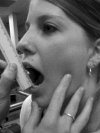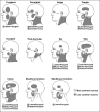Management and treatment of temporomandibular disorders: a clinical perspective
- PMID: 20140156
- PMCID: PMC2813497
- DOI: 10.1179/106698109791352184
Management and treatment of temporomandibular disorders: a clinical perspective
Abstract
A temporomandibular disorder (TMD) is a very common problem affecting up to 33% of individuals within their lifetime. TMD is often viewed as a repetitive motion disorder of the masticatory structures and has many similarities to musculoskeletal disorders of other parts of the body. Treatment often involves similar principles as other regions as well. However, patients with TMD and concurrent cervical pain exhibit a complex symptomatic behavior that is more challenging than isolated TMD symptoms. Although routinely managed by medical and dental practitioners, TMD may be more effectively cared for when physical therapists are involved in the treatment process. Hence, a listing of situations when practitioners should consider referring TMD patients to a physical therapist can be provided to the practitioners in each physical therapist's region. This paper should assist physical therapists with evaluating, treating, insurance billing, and obtaining referrals for TMD patients.
Keywords: Dentistry; Physical Therapy; Temporomandibular Disorders; Temporomandibular Joint.
Figures





Similar articles
-
Cause-Effect Relationships between Painful TMD and Postural and Functional Changes in the Musculoskeletal System: A Preliminary Report.Pain Res Manag. 2022 Feb 28;2022:1429932. doi: 10.1155/2022/1429932. eCollection 2022. Pain Res Manag. 2022. PMID: 35265232 Free PMC article.
-
Temporomandibular disorders: A position paper of the International College of Cranio-Mandibular Orthopedics (ICCMO).Cranio. 2011 Jul;29(3):237-44. doi: 10.1179/crn.2011.034. Cranio. 2011. PMID: 22586834
-
Pharmacotherapy in Temporomandibular Disorders: A Review.J Can Dent Assoc. 2017 Jul;83:h7. J Can Dent Assoc. 2017. PMID: 29513209 Review.
-
The effectiveness of manual therapy applied to craniomandibular structures in the treatment of temporomandibular disorders: protocol for a systematic review.Syst Rev. 2021 Mar 8;10(1):70. doi: 10.1186/s13643-021-01623-7. Syst Rev. 2021. PMID: 33685496 Free PMC article.
-
Nonpharmacologic approaches to the management of myofascial temporomandibular disorders.Curr Pain Headache Rep. 2001 Oct;5(5):421-31. doi: 10.1007/s11916-001-0053-7. Curr Pain Headache Rep. 2001. PMID: 11560807 Review.
Cited by
-
Evaluation and management of temporomandibular disorders. Part 2: an orthopaedic physical therapy update on examination and clinical reasoning.J Man Manip Ther. 2023 Jun;31(3):143-152. doi: 10.1080/10669817.2022.2124617. Epub 2022 Sep 28. J Man Manip Ther. 2023. PMID: 36171740 Free PMC article.
-
Temporomandibular Disorder Diagnostic Groups Affect Outcomes Independently of Treatment in Patients at Risk for Developing Chronicity: A 2-Year Follow-Up Study.J Oral Facial Pain Headache. 2016 Summer;30(3):187-202. doi: 10.11607/ofph.1613. J Oral Facial Pain Headache. 2016. PMID: 27472521 Free PMC article.
-
An Integrative Model Accounting for the Symptom Cluster Triggered After an Acoustic Shock.Trends Hear. 2018 Jan-Dec;22:2331216518801725. doi: 10.1177/2331216518801725. Trends Hear. 2018. PMID: 30249168 Free PMC article. Review.
-
Arthrocentesis of Temporomandibular Joint- Bridging the Gap Between Non-Surgical and Surgical Treatment.Ann Maxillofac Surg. 2019 Jan-Jun;9(1):158-167. doi: 10.4103/ams.ams_160_17. Ann Maxillofac Surg. 2019. PMID: 31293946 Free PMC article. Review.
-
Comparative effectiveness of Low Level Laser therapy and Transcutaneous Electric Nerve Stimulation on Temporomandibular Joint Disorders.J Lasers Med Sci. 2017 Summer;8(Suppl 1):S27-S31. doi: 10.15171/jlms.2017.s6. Epub 2017 Aug 29. J Lasers Med Sci. 2017. PMID: 29071032 Free PMC article.
References
-
- American Academy of Orofacial Pain . In: Orofacial Pain: Guidelines for Assessment, Diagnosis and Management, 4th ed. de Leeuw R, editor. Chicago: Quintessence; 2008.
-
- Wright EF. Manual of Temporomandibular Disorders. Ames, IA: Blackwell; 2005.
-
- Okeson JP. Management of Temporomandibular Disorders and Occlusion, 6th ed. St. Louis, MO: CV Mosby; 2008.
-
- Fricton J. Myogenous temporomandibular disorders: Diagnostic and management considerations. Dent Clin North Am. 2007;51:61–83. - PubMed
-
- Murphy E. Managing Orofacial Pain in Practice. Chicago: Quintessence; 2008.
LinkOut - more resources
Full Text Sources
Other Literature Sources
Medical
